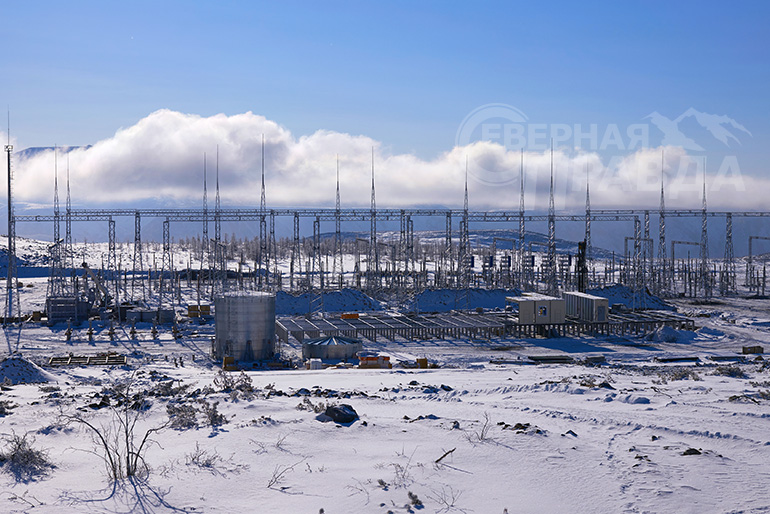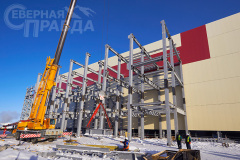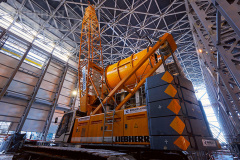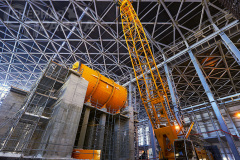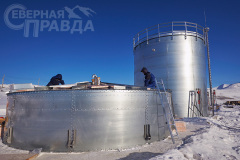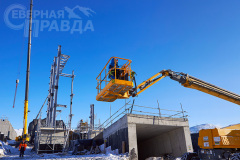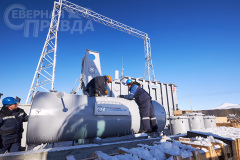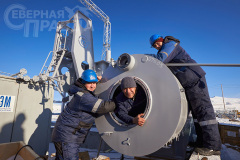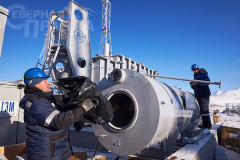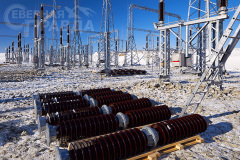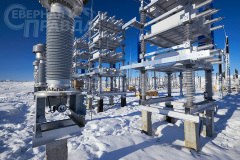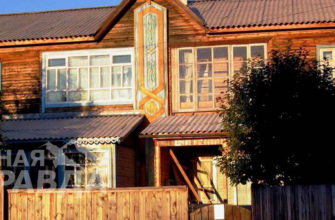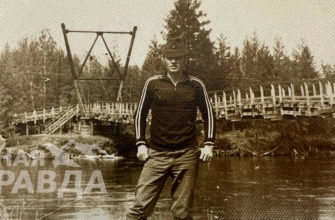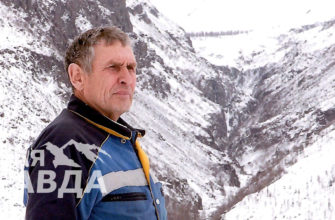Based on materials from the book by Anatoly Snegur «Udokan Horizons».
How did it all begin?
“… On June 29, 1949, Klava and VP were given a route along an unnamed stream flowing into the Naminga River on the left. Our group had to climb the watershed and walk another 3-4 kilometers along it, and then descend from the ridge a kilometer from the beginning of the course … The morning was gray, foggy, at night it was raining cats and dogs, so bushes and trees at the slightest touch washed us down with water from head to toe. The first part of the route went along the spring watercourse … we nicknamed it Slippery. I accidentally found the first pieces of copper ore in about the middle part of the spring. But as we moved towards the upper reaches, the green pieces began to come across more and more often, so I decided that they had been brought from above. The opinion was confirmed by new findings. However, at the very top of the spring, almost at the approaches to the watershed, a stormy waterfall 5–6 meters high blocked our way, which turned out to be too difficult to get round. And then, in addition to all the difficulties, when knocking off rock samples, a hammer accidentally slipped out of my hands and fell into the water. VP several times dived after it into the cauldron at the base of the waterfall, but couldn’t get it because of the depth (only a year later, the hammer was carried by water into the wider part of the spring, where geologists picked it up). At the watershed, we were suddenly struck by the abundance of blue and green colors — signs of copper ore. The necessary geological observations, sketches, descriptions, ore sampling were made. A day passed unnoticed doing this work, and we had to walk another four kilometers of the route. It was clear that it had to be postponed and before it got dark, we hastily descended from the ridge. We reached the camp already in the dull twilight, and there they were looking for us — they shouted, shot, burned fires..”
This is how Elizaveta Burova described that momentous day when she discovered copper deposits at Udokan. It was a find that she dreamed of being a student.
Copper attracted, so almost immediately the first scouting party was formed, which worked in Udokan in 1950-1951. In 1953, the first 18 kilometers of the road from the village of Chara towards Naminga were built. In May 1953 the Saku section was organized.
As of June 11, 1953, the party consisted of the following divisions:
management — 9 people;
accounting department — 4 people;
base in the village of Chara — 10 people;
road crew — 6 people;
central section — 20 people;
power plant and vehicles — 5 people;
mining workshop — 6 people;
adit — 28 people;
taking and processing samples — 5 people;
Western section — 26 people;
Eastern section — 16 people;
digging of the exploratory gallery- 9 people.
A total of 144 people.
By the end of 1953, the party had created sites of Naminga, Nerundukan, 27th kilometer, Klyukvenny, 21st kilometer and Slippery. 198 people worked for them. In October 1955, for the first time, the orders listed the «Udogan exploration expedition», in the same October, the «Udokan expedition» appeared.
In May 1959, by order of the Ministry of Geology, the work on Udokan was suspended, the equipment was mothballed, and the workers were taken out. This happened because on Udokan the leading geologists used the same technology, by analogy with other deposits, and came to the conclusion that the spread of mineralization to depth was futile. However, the well, laid at the initiative of the chief geologist of the expedition, Korolkov, from the second adit, broke the opinion of skeptics. Data were obtained from it, confirming the most optimistic forecasts of geologists. As a result, funding was resumed, and the expedition started working again. Its tasks included geological surveying and prospecting in the surrounding area, exploration of building materials and fuel for the needs of the construction of a future plant. All work was scheduled to be completed in the second half of 1964. The very first results obtained in the main directions confirmed the promise of Udokan.
For the work of the expedition, transport was needed, the Chita aviators had to deliver more than a thousand tons of cargo to Chara. At Chara airport it was necessary to base at least two helicopters for the needs of the Udokans, and from Chara to Naminga there was only one road suitable for driving only in winter.
The year of preparation for the big spread of works was 1960. The Communists spoke of the need to increase training to expand the work in the adits. Near the fourth, not far from the Ingamakit pass, high in the mountains, at an elevation of 2 thousand meters, preparations were being made to start work on adit 5. The purpose of these adits was to explore the southeastern flank of the ore field.
In November 1960, at the district party meeting, the Udokans reported on the completion of all tasks, the completion of the reconstruction of the surface economy at the third adit, the construction of a power line to the fourth and fifth adits, the opening of a club for 350 seats and the beginning of the academic year at the Naminga seven-year school.
Why the fifth? Only in the 90s did it become possible to talk about a monstrous and, to our great happiness, a failed experiment — a nuclear explosion, which was being prepared in the mountains of northern Transbaikalia, in the center of the famous Udokan. Yes, it didn’t take place. But there was a dull echo of those events. And we must know about it at least in order to forever protect ourselves from such catastrophic adventures, from our irrepressible and far from clever desire to conquer nature.
So, on August 24, 1964, the first stage of exploration of the Udokan field was successfully completed. And soon the party directive line “To start developing the Udokan copper ore deposit” appeared. It still walked around the Kremlin offices, and the Minister of Medium Machine Building Slavsky had already flown to the north of Transbaikalia. The Minister found the local conditions (the Chita-Chara air route, the Mogocha station and the Mogocha-Chara autowinter) quite suitable. And everything started spinning. By that time, 8 adits had been completed at the deposit, but the fifth was chosen. Why the fifth, even not the most comfortable? Maybe because there were not only peaceful goals, but also military ones?
«The main purpose of the explosion was, of course, the overburden of this part of the deposit. And the fifth adit was chosen because it had the most favorable conditions, there was place where to put this overburden.»
However, there is another opinion. “Why did they decide to start the development of the deposit from the poorest part of it? After all, the main reserves of copper, handed over to the State Commission on Reserves in 1964, fell on neighboring mountains with adits of the first, second, third … They could get the maximum national economic effect. if military goals were in the first place, and only a ready-made adit in a remote and sparsely populated area was required. Then the fifth one was quite reasonable», — so reasoned the head of the geological department of the Udokan expedition Vitaly Sunkinzyan.
Anatoly Snegur wasn’t satisfied with either one or the other answer: «The choice of the adit remained a mystery. And the answer, as usual, was found according to the same principle: look and find.” Vasily Nikolayevich Klimenko. A veteran of the Udokan veterans. The man who had to leave it last at rush hour. The man who enjoyed access to the most secret sites of the planned explosion.
— Why the fifth? Why the poorest? He asks. — As you understand, I haven’t seen any documents on this score. But I asked a lot of questions myself many times. And I received the answer, as they say, at first hand. The fifth adit was just an experiment. And the device they promised to bring was experimental. If the test had passed successfully, and in my opinion, no one doubted this, then the second stage would have entered into force. According to him, Sredmash (the USSR Ministry of Medium Machine Building), himself or with our help, had to lay 9 more nuclear devices on Udokan. Then the main ore reserves would have been discovered.”
We made concrete lintels, fastened the rails, expanded the adit by 90 centimeters, straightening it. And mostly, to be honest, played dominoes. We prepared for the acceptance of the charge quickly, the further didn’t depend on us. Of course, no one could tell us the exact date. And who knew it in Naming? The only thing we were firmly assured of was that the regional center Chara would remain in place and wouldn’t suffer. Oh, these assurances, now we know their value. All people in geological settlements were supposed to be evacuated. Not only from Naminga and Zapadny, but also from those in Ingamakit — it is much further, from China and Burpala — it is already within 25-50 kilometers, from the mine of the XI years of October and the village of Chapo-Ologo — it is already 100– 150 kilometers. In short, all geological exploration in and around Udokan was going to close down for decades. In the Chara valley, adjacent to Udokan, apart from exploration sites, there were only two villages — Chapo-Ologo and the regional center Chara. The first was evacuated, the second wasn’t. And the workers were not in vain interested in its fate. After all, Chara, in comparison with the Evenk Chapo-Ologo, is two times closer to the fifth adit. The rest of the conditions were almost the same. Well, the regional center was spellbound by radiation, or what? Riddle. Most likely, the evacuation of such a large settlement could cause unwanted publicity. And back then they feared that much more than radiation.
Tunneling Khairulin
Excerpt from a letter from the former Udokan tunneller Ivan Chechulin. He is a direct participant in those works at the fifth adit. Ivan Vasilievich writes:
“… We were told to work as one should, then we will be paid average weekly. We agreed, of course. It is true that the best tunnellers were selected … How many times did we crawl these 700 meters ?! Back and forth on your knees, probing each crutch every time, and even more so the joint. They even sawed the joints with a rasp … While it was warm, they made access roads. The stones got broken by hand with sledgehammers. They needed 1,200 cubic meters of them to pave the adit before the «figure» was brought in. We called it like that. And then we had to concrete everything. But we didn’t have time to do this. The reasons, of course, we didn’t know. If people worked like this now, like we did then ?! And the model of the «figure» was ten tons in weight, with a drill shot inside. And we rolled it by hand on the sly to check all the gaps, as well as the joints. And God forbid, as they say now, that something would hurt somewhere … When the camera was made, soldiers came to us, there were also civilians. They pulled the cable. We took our passport to work. Entering the adit, we gave it to the sentry, and upon leaving, he returned it to us … «.
By July 1965, the charge chamber in the fifth adit was ready. The Chita-Chara air route worked without a break. Airplanes circled all daylight. They brought equipment, materials, products, specialists. At the airport, all this was loaded onto cars. However, nature seemed to anticipate trouble, interfered as best as it could. The wayward Chara overflowed the banks, demolished the crossing, washed away the first two kilometers of the road. But soon the water subsided.
And more and more specialists came from the center. They entangled the mountain and the adit with a cable, installed and debugged equipment and measuring instruments in it. In late autumn, a whole train with a mock nuclear device was rolled on the rails. They waited for frosts, which would have tightened the rivers on the winter road from Mogocha to Naminga. With the arrival of winter on December 5, new KrAZ trucks with specialists arrived in Mogocha on the platform. We loaded each of the cars with ten tons of sand, and, accompanied by security guards and Mogochin drivers, were sent in the direction of Naminga, for running-fitting.
The head of the Mogochinsky section, Goryachyov, recalls: “The run-in went well. Our cars and the KrAZ trucks that arrived were preparing for the last voyage. We understood that after the explosion, the road to Udokan from Mogocha would be closed for decades. We were glad anyway that all the work done wasn’t in vain and there would be a mine in the north of the region … We already knew that the charge had arrived in Mogocha. X-days were appointed from January 2 to 6, 1966. By this time, the charge should be in the adit, meteorologists give an acceptable «wind rose», evacuation completed. »
However, the charge didn’t go beyond the coast of Olekma. While the ice was being tested on the river, while they were getting ready to move on, the command «lights out» came. The then Minister of Foreign Affairs Andrei Gromyko is believed to have been most involved in it. In the end, common sense won out.
And what would happen if you thundered that even a single explosion? Now, knowing the bitter experience of Chernobyl, the Semipalatinsk test site, the South Ural factories, it is not so difficult to imagine. The explosion was supposed to thunder at an altitude of 1,656 meters above sea level, where there were practically no barriers to the atomic cloud. It could hang for a whole month or more over Udokan and the Chara Valley, since these places are distinguished primarily by calmness. And if there is a wind, then its average monthly speed does not exceed 0.8 meters per second. Scientists say that such a speed is nothing, but it will be quite enough to spread radioactive waste to all the adjacent areas of the Amur and Chita regions, and maybe even further.
And since the rocks of Udokan are distinguished by high fracturing and faults, all the waste of the nuclear device, sooner or later, had to get into the nearest rivers Namingu and Ingamakit, then into the Chara, Olekma, Lena up to the Arctic Ocean. And it is unlikely that the BAM would have passed through the Chara Valley and Udokan. And it is unlikely that at least one person would live there today.
Then, in the 60s, the forthcoming explosion became good news for exploration specialists, because the development of the field began, which was the main goal of their work. Few people understood what monstrous consequences could follow the explosion, if it actually happened. Perhaps not Chernobyl, but Udokan would become synonymous with a radiation disaster known to the whole world.
What’s going on now?
In August 2020, the «Baikal Mining Company» began the first work on overburden and associated mining of copper ore. This happened ahead of schedule, since it was planned for 2021.
The first stage includes two sites.
«Capital mining operations envisage the opening of the Udokan deposit in order to open access to mineral deposits. In fact, this event has been expected by the entire industry since the discovery of Udokan,» commented Valery Kazikayev, chairman of the board of directors of BGK.
More than 1.1 million tons of ore is planned to be mined even before the open pit is put into operation.
https://www.chita.ru/articles/149333/,
Translated by ILYA MIKHIN

